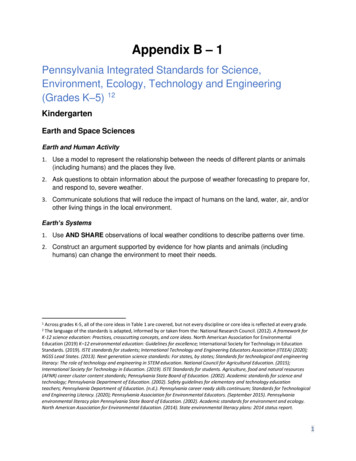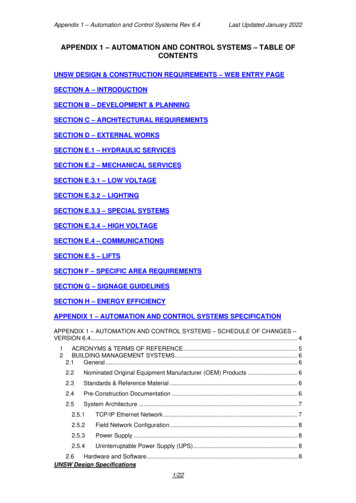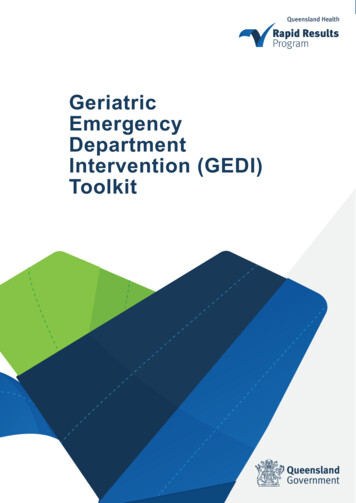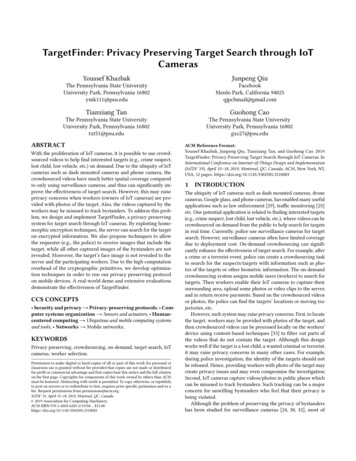
Transcription
Appendix B – 1Pennsylvania Integrated Standards for Science,Environment, Ecology, Technology and Engineering(Grades K–5) 12KindergartenEarth and Space SciencesEarth and Human Activity1. Use a model to represent the relationship between the needs of different plants or animals(including humans) and the places they live.2. Ask questions to obtain information about the purpose of weather forecasting to prepare for,and respond to, severe weather.3. Communicate solutions that will reduce the impact of humans on the land, water, air, and/orother living things in the local environment.Earth’s Systems1. Use AND SHARE observations of local weather conditions to describe patterns over time.2. Construct an argument supported by evidence for how plants and animals (includinghumans) can change the environment to meet their needs.1 Across gradesK-5, all of the core ideas in Table 1 are covered, but not every discipline or core idea is reflected at every grade.language of the standards is adapted, informed by or taken from the: National Research Council. (2012). A framework forK-12 science education: Practices, crosscutting concepts, and core ideas. North American Association for EnvironmentalEducation (2019) K–12 environmental education: Guidelines for excellence; International Society for Technology in EducationStandards. (2019). ISTE standards for students; International Technology and Engineering Educators Association (ITEEA) (2020);NGSS Lead States. (2013). Next generation science standards: For states, by states; Standards for technological and engineeringliteracy: The role of technology and engineering in STEM education. National Council for Agricultural Education. (2015);International Society for Technology in Education. (2019). ISTE Standards for students. Agriculture, food and natural resources(AFNR) career cluster content standards; Pennsylvania State Board of Education. (2002). Academic standards for science andtechnology; Pennsylvania Department of Education. (2002). Safety guidelines for elementary and technology educationteachers; Pennsylvania Department of Education. (n.d.). Pennsylvania career ready skills continuum; Standards for Technologicaland Engineering Literacy. (2020); Pennsylvania Association for Environmental Educators. (September 2015). Pennsylvaniaenvironmental literacy plan Pennsylvania State Board of Education. (2002). Academic standards for environment and ecology.North American Association for Environmental Education. (2014). State environmental literacy plans: 2014 status report.2 The1
Life ScienceFrom Molecules to Organisms: Structures and Processes1. Use observations to describe patterns of what plants and animals (including humans) needto survive.Physical ScienceMotion and Stability: Forces and Interactions1. Plan and conduct an investigation to compare the effects of different strengths or differentdirections of pushes and pulls on the motion of an object.2. Analyze data to determine if a design solution works as intended to change the speed ordirection of an object with a push or a pull.Energy1. Make observations to determine the effect of sunlight on Earth’s surface.2. Use tools and materials to design and build a structure that will reduce the warming effect ofsunlight on an area.Grade 1Earth and Space SciencesEarth’s Place in the Universe1. Use observations of the sun, moon, and stars to describe patterns that can be predicted.2. Make observations at different times of year to relate the amount of daylight to the time ofyear.Life ScienceFrom Molecules to Organisms: Structures and Processes1. Use materials to design a solution to a human problem by mimicking how plants and/oranimals use their external parts to help them survive, grow, and meet their needs.2. Read texts and use media to determine patterns in behavior of parents and offspring thathelp offspring survive.Heredity: Inheritance and Variation of Traits1. Make observations to construct an evidence-based account that young plants and animalsare like, but not exactly like, their parents.I2
Physical ScienceWaves and Their Applications in Technologies for Information Transfer1. Plan and conduct investigations to provide evidence that vibrating materials can makesound and that sound can make materials vibrate.2. Make observations to construct an evidence-based account that objects can be seen onlywhen illuminated.3. Plan and conduct an investigation to determine the effect of placing objects made withdifferent materials in the path of a beam of light.4. Use tools and materials to design and build a device that uses light or sound to solve theproblem of communicating over a distance.Grade 2Earth and Space SciencesEarth’s Place in the Universe1. Use information from several sources to provide evidence that Earth events can occurquickly or slowly.Earth’s Systems1. Compare multiple solutions designed to slow or prevent wind or water from changing theshape of the land.2. Develop a model to represent the shapes and kinds of land and bodies of water in an area.3. Obtain information to identify where water is found on Earth and that it can be solid or liquid.Life ScienceEcosystems: Interactions, Energy, and Dynamics1. Plan and conduct an investigation to determine if plants need sunlight and water to grow.2. Develop a simple model that mimics the function of an animal in dispersing seeds orpollinating plants.Biological Evolution: Unity and Diversity1. Make observations of plants and animals to compare the diversity of life in different habitats.Matter and its Interactions1. Plan and conduct an investigation to describe and classify different kinds of materials bytheir observable properties.I3
2. Analyze data obtained from testing different materials to determine which materials have theproperties that are best suited for an intended purpose.3. Make observations to construct an evidence-based account of how an object made of asmall set of pieces can be disassembled and made into a new object.4. Construct an argument with evidence that some changes caused by heating or cooling canbe reversed and some cannot.Grade 3Earth and Space SciencesEarth’s Systems1. Represent data in tables and graphical displays to describe typical weather conditionsexpected during a particular season.2. Obtain and combine information to describe climates in different regions of the world.Earth and Human Activity1. Make a claim supported by evidence about the merit of a design solution that reduces theimpacts of a weather-related hazard.Life ScienceFrom Molecules to Organisms: Structures and Processes1. Develop models to describe that organisms have unique and diverse life cycles but all havein common birth, growth, reproduction, and death.Ecosystems: Interactions, Energy, and Dynamics1. Construct an argument that some animals have physical and behavioral adaptations thatFORM GROUPS THAT help members survive.Heredity: Inheritance and Variation of Traits1. Analyze and interpret data to provide evidence that plants and animals have traits inheritedfrom parents and that variation of these traits exists in a group of similar organisms.2. Use evidence to support the explanation that traits can be influenced by the environment.Biological Evolution: Unity and Diversity1. Analyze and interpret data from fossils to provide evidence of the organisms and theenvironments in which they lived long ago.4
2. Use evidence to construct an explanation for how the variations in characteristics amongindividuals of the same species may provide advantages in surviving, finding mates, andreproducing.3. Construct an argument with evidence that in a particular habitat some organisms cansurvive well, some survive less well, and some cannot survive at all.4. Make a claim supported by evidence about the merit of a solution to a problem caused when theenvironment changes and the types of plants and animals that live there may change.Physical ScienceMotion and Stability: Forces and Interactions1. Plan and conduct an investigation to provide evidence of the effects of balanced andunbalanced forces on the motion of an object.2. Make and communicate observations and/or measurements of an object’s motion to provideevidence that a pattern can be used to predict future motion.3. Ask questions to determine cause and effect relationships of electric or magneticinteractions between two objects not in contact with each other.4. Define a simple design problem that can be solved by applying scientific ideas aboutmagnets.Grade 4Earth and Space SciencesEarth’s Place in the Universe1. Identify evidence from patterns in rock formations and fossils in rock layers to support anexplanation for changes in a landscape over time.Earth’s Systems1. Make observations and/or measurements to provide evidence of the effects of weathering orthe rate of erosion by water, ice, wind, or vegetation.2. Analyze and interpret data from maps to describe patterns of Earth’s features.Earth and Human Activity1. Obtain and combine information to describe that energy and fuels are derived from naturalresources and their uses affect the environment.2. Generate and compare multiple solutions to reduce the impacts of natural Earth processeson humans.I5
Life ScienceFrom Molecules to Organisms: Structures and Processes1. Construct an argument that plants and animals have internal and external structures thatfunction to support survival, growth, behavior, and reproduction.2. Use a model to describe that animals receive different types of information through theirsenses, process the information in their brain, and respond to the information in differentways.Physical ScienceWaves and Their Applications in Technologies for Information Transfer1. Develop a model of waves to describe patterns in terms of amplitude and wavelength andthat waves can cause objects to move.2. Develop a model to describe that light reflecting from objects and entering the eye allowsobjects to be seen.3. Generate and compare multiple solutions that use patterns to transfer information.Energy1. Use evidence to construct an explanation relating the speed of an object to the energy ofthat object.2. Make and communicate observations to provide evidence that energy can be transferredfrom place to place by sound, light, heat, and electric currents.3. Ask questions and predict outcomes about the changes in energy that occur when objectscollide.4. Apply scientific ideas to design, test, and refine a device that converts energy from one formto another.Grade 5Earth and Space SciencesEarth’s Place in the Universe1. Support an argument that differences in the apparent brightness of the sun compared toother stars is due to their relative distances from Earth.2. Represent data in graphical displays to reveal patterns of daily changes in length anddirection of shadows, day and night, and the seasonal appearance of some stars in the nightsky.I6
Earth’s Systems1. Develop a model using an example to describe ways the geosphere, biosphere,hydrosphere, and/or atmosphere interact.2. Describe and graph the amounts and percentages of water and fresh water in variousreservoirs to provide evidence about the distribution of water on Earth.Earth and Human Activity1. Obtain and combine information about ways individual communities use science ideas toprotect the Earth’s resources and environment.2. Generate and design possible solutions to a current environmental issue, threat, or concern.Life ScienceFrom Molecules to Organisms: Structures and Processes1. Support an argument that plants get the materials they need for growth chiefly from air andwater.Ecosystems: Interactions, Energy, and Dynamics1. Develop a model to describe the movement of matter among plants, animals, decomposers,and the environment.Physical ScienceMatter and Its Interactions1. Develop a model to describe that matter is made of particles too small to be seen.2. Measure and graph quantities to provide evidence that regardless of the type of change thatoccurs when heating, cooling, or mixing substances, the total weight of matter is conserved.3. Make and communicate observations and measurements to identify materials based ontheir properties.4. Conduct an investigation to determine whether the mixing of two or more substances resultsin new substances.5. Interpret and analyze data and observations to make decisions about how to utilizematerials based on their properties.Motion and Stability: Forces and Interactions1. Support an argument that the gravitational force exerted by Earth on objects is directeddown.7
Energy1. Use models to describe that energy in animals’ food (used for body repair, growth, motion,and to maintain body warmth) was once energy from the sun.I8
Standards by Grade BandGrades K–2: Environment and Ecology ENVIRONMENTAL LITERACYAND SUSTAINABILITYDecision-Making and Action Skills1. Examine and express their own views on environmental issues.2. Determine whether action is needed on selected environmental issues and whether theyshould be involved. They describe their reasoning.3. Develop an action strategy or design solution for a specific local environmental issue of theirchoosing.4. Identify environmental and social consequences of design solutions and civic actions, includingtheir own actions.Personal and Civic Responsibility1. Describe their basic rights and responsibilities as members of a community and theimportance of these rights and responsibilities in promoting environmental quality andcommunity well-being.2. Describe how they can realistically and meaningfully contribute to their community andenvironmental quality.3. Identify ways in which they are responsible for the environmental and social effects of theiractions.Earth’s Physical and Living Systems1. Describe characteristics of Earth’s physical systems, including air, water, and land. Theyexplain how these systems interact with one another and identify changes in the physicalenvironment over time. They provide examples of how physical systems affect living organisms,including humans.2. Identify basic similarities and differences among a wide variety of living organisms. They explainways that living organisms, including humans, affect the environment in which they live, and howtheir environment affects them.Human Systems1. Generate examples of how people act, as individuals, as members of a group, and as membersof society, toward the environment. They articulate their own beliefs and the beliefs of family andcommunity members about the environment and environmental issues.2. Identify ways that people express different cultural backgrounds and how these can influenceenvironmental perceptions and activities.9
AGRICULTURAL AND ENVIRONMENTAL SYSTEMS AND RESOURCES1. EXAMINE HOW PEOPLE FROM DIFFERENT CULTURES AND COMMUNITIES,INCLUDING ONE’S OWN, INTERACT AND EXPRESS THEIR BELIEFS ABOUT NATURE.Environment and Society1. Identify ways that people depend on, change, and are affected by the environment.2. Describe 2. CATEGORIZE ways people harvest, re-distribute, and use natural resources.ENVIRONMENTAL LITERACY SKILLS3. Identify 1. EXPLAIN ways that places differ in their physical and human characteristics, THEIRMEANING, AND THEIR VALUE AND/OR IMPORTANCE.4. Recognize that change is a normal part of individual and societal life.Skills for Analyzing and Investigating Environmental Issues1. Identify and investigate issues 2. PLAN AND CARRY OUT AN INVESTIGATION TOADDRESS AN ISSSUE in their local environment and community.2. Use their knowledge of how ecological and human systems are interconnected todescribe the environmental and social consequences of local environmental issues.3. Develop plans, including possible design solutions, for addressing selected localenvironmental issues.4. Demonstrate openness and receptivity while listening to and working with others who haveperspectives about the environment that are different from their own.Grades K–2: Technology and EngineeringApplying, Maintaining, and Assessing Technological Products andSystems1. Analyze how things work.2. Identify and use everyday symbols.3. Describe qualities of everyday products.Core Concepts of Technology and Engineering1. Illustrate how systems have parts or components that work together to accomplish a goal.2. Safely use tools to complete tasks.3. Explain that materials are selected for use because they possess desirable properties and10
characteristics.4. Develop a plan in order to complete a task.5. Collaborate effectively as a member of a team.Design in Technology and Engineering Education1. Apply design concepts, principles, and processes through play and exploration.2. Demonstrate that designs have requirements.3. Explain that design is a response to wants and needs.4. Discuss that all designs have different characteristics that can be described.5. Illustrate that there are different solutions to a design and that none are perfect.6. Demonstrate essential skills of the engineering design process.7. Apply skills necessary for making in design.History of Technology1.Discuss how the way people live and work has changed throughout history because oftechnology.Impacts of Technology1. Explain ways that technology helps with everyday tasks.2. Illustrate helpful and harmful effects of technology.3. Compare simple technologies to evaluate their impacts.4. Select ways to reduce, reuse, and recycle resources in daily life.5. Design new technologies that could improve their daily lives.Influence of Society on Technological Development1. Explain the needs and wants of individuals and societies.2. Explore how technologies are developed to meet individual and societal needs and wants.3. Investigate the use of technologies in the home and community.Integration of Knowledge, Technologies, and Practices1. Apply concepts and skills from technology and engineering activities that reinforce conceptsand skills across multiple content areas.2. Draw connections between technology and human experiences.Nature and Characteristics of Technology and Engineering1. Compare the natural world and human-made world.2. Explain the tools and techniques that people use to help them do things.11
3. Demonstrate that creating can be done by anyone.4. Discuss the roles of scientists, engineers, technologists and others who work withtechnology.12
Grades 3–5: Environment and Ecology ENVIRONMENTAL LITERACYAND SUSTAINABILITYDecision-Making and Action Skills1. Identify, justify, and clarify their views on environmental issues and alternative ways toaddress them.2. Evaluate whether action is needed in specific situations, using environmental, cultural/social,and economic criteria. They decide whether they should be involved in that action.3. Use their research results to develop action strategies and design solutions at levelsconsistent with their maturity and preparation. As appropriate, they implement their plans.4. Analyze the effects of design solutions, their own civic actions, and actions taken by otherindividuals and groups. They describe the short- and long-term effects of these actions anddesign solutions in terms of environmental, social, and economic consequences.Personal and Civic Responsibility1. Explain the rights and responsibilities of community membership and their role in addressingenvironmental quality and sustainability.2. Possess a realistic self-confidence in their effectiveness as community members to makechanges in their community that address environmental quality and sustainability.3. Describe the broad environmental, social, and economic consequences of their personaland group actions and as appropriate, accept responsibility for their actions.Earth's Physical and Living Systems1. Describe the physical processes that shape Earth, including weather, climate, platetectonics, and the hydrologic cycle. They explain how matter cycles and energy flowsamong the abiotic and biotic components of the environment. They describe how humansaffect and are affected by Earth’s physical systems.2. Describe how living things, including humans, are dependent on their environment and areadapted to live in particular ecosystems under particular environmental conditions. Theydescribe major interactions among organisms and populations of organisms and explain theimportance of biodiversity to ecosystem health. They describe how humans affect and areaffected by the biosphere.AGRICULTURAL AND ENVIRONMENTAL SYSTEMS AND RESOURCES1. ANALYZE HOW LIVING ORGANISMS, INCLUDING HUMANS, AFFECT THEENVIRONMENT IN WHICH THEY LIVE, AND HOW THEIR ENVIRONMENT AFFECTSTHEM.Human Systems1. Explain ways that individual traits and group membership or affiliation influence perceptions13
of and actions toward the environment. They describe how their environmental beliefs andvalues are shaped by their community and the larger society. They compare their beliefsand values to those held by others in their community.2. Describe examples of the interconnection between cultural perspectives and theenvironment.3. Describe how political systems at varying scales account for, manage, and affect naturalresources and environmental quality.4. Describe how economic systems and economic decision-making influence natural resourceuse and management as well as environmental and human well-being.2. MAKE A CLAIM ABOUT THE ENVIRONMENTAL AND SOCIAL IMPACTS OF DESIGNSOLUTIONS AND CIVIC ACTIONS, INCLUDING THEIR OWN ACTIONS.Environment and Society ENVIRONMENTAL LITERACY SKILLS1. Describe human-caused changes that affect the immediate environment as well as otherplaces, other people, and future times.2. Explain that uneven geographic distribution of natural resources influences their use andperceived value.3. Describe the meaning of “place” both close to home and around the world.4. Explain that human social systems are dynamic and that conflicts sometimes arise overdiffering and changing viewpoints about the environment and natural resource use andmanagement.1. INVESTIGATE HOW PERSPECTIVES OVER THE USE OF RESOURCES AND THEDEVELOPMENT OF TECHNOLOGY HAVE CHANGED OVER TIME AND RESULTED INCONFLICT OVER THE DEVELOPMENT OF SOCIETIES AND NATIONS.Skills for Analyzing and Investigating Environmental Issues1. Use primary and secondary sources of information and apply research and analytical skillsto investigate environmental issues, beginning in their own community and region.2. Apply their knowledge of ecological and human processes and systems to describe theshort- and long- term consequences of selected environmental issues on sustainability.3. Identify and develop action strategies, including design solutions, appropriate for addressinga range of environmental issues at community and regional levels. They describe how theiraction strategies and design solutions might impact environmental quality and other peoplenow and in the future.4. Demonstrate active listening, tolerance, adaptability, and openness as they work with othersto gather a range of perspectives and information.2. DEVELOP A MODEL TO DEMONSTRATE HOW LOCAL ENVIRONMENTAL ISSUES ARECONNECTED TO LARGER LOCAL ENVIRONMENT AND HUMAN SYSTEMS.14
SUSTAINABILITY AND STEWARDSHIP1. CRITIQUE WAYS THAT PEOPLE DEPEND ON AND CHANGE THEENVIRONMENT.2. EXAMINE WAYS YOU INFLUENCE YOUR LOCAL ENVIRONMENT ANDCOMMUNITY BY COLLECTING AND DISPLAYING DATA.3. CONSTRUCT AN ARGUMENT TO SUPPORT WHETHER ACTION IS NEEDED ONA SELECTED ENVIRONMENTAL ISSUE AND PROPOSE POSSIBLE SOLUTIONS.Grades 3–5: Technology and EngineeringApplying, Maintaining, and Assessing Technological Products andSystems1. Follow directions to complete a technological task.2. Use appropriate symbols, numbers and words to communicate key ideas abouttechnological products and systems.3. Identify why a product or system is not working properly.4. Examine information to assess the trade-offs of using a product or system.Core Concepts of Technology and Engineering1. Describe how a subsystem is a system that operates as a part of another larger system.2. Illustrate how, when parts of a system are missing, it may not work as planned.3. Identify the resources needed to get a technical job done, such as people, materials, capital,tools, machines, knowledge, energy, and time.4. Describe the properties of different materials.5. Demonstrate how tools and machines extend human capabilities, such as holding, lifting,carrying, fastening, separating, and computing.6. Describe requirements of designing or making a product or system.7. Create a new product that improves someone's life.Design in Technology and Engineering Education1. Illustrate that there are multiple approaches to design.2. Demonstrate essential skills of the engineering design process.3. Evaluate designs based on criteria, constraints, and standards.4. Interpret how good design improves the human condition.5. Apply universal principles and elements of design.6. Evaluate the strengths and weaknesses of existing design solutions, including theirown solutions.15
7. Practice successful design skills.8. Apply tools, techniques, and materials in a safe manner as part of the design process.History of Technology1. Create representations of the tools people made, how they cultivated to provide food, madeclothing, and built shelters to protect themselves.Impacts of Technology1. Describe the helpful and harmful effects of technology.2. Judge technologies to determine the best one to use to complete a given task or meeta need.3. Classify resources used to create technologies as either renewable or nonrenewable.4. Explain why responsible use of technology requires sustainable management of resources.5. Predict how certain aspects of their daily lives would be different without given technologies.Influence of Society on Technological Development1. Determine factors that influence changes in a society’s technological systems orinfrastructure.2. Explain how technologies are developed or adapted when individual or societal needs andwants change.Integration of Knowledge, Technologies, and Practices1. Demonstrate how simple technologies are often combined to form more complex systems.2. Explain how various relationships can exist between technology and engineering and othercontent areas.Nature and Characteristics of Technology and Engineering1. Compare how things found in nature differ from things that are human-made, notingdifferences and similarities in how they are produced and used.2. Describe the unique relationship between science and technology, and how the naturalworld can contribute to the human-made world to foster innovation.3. Differentiate between the role of scientists, engineers, technologists, and others in creatingand maintaining technological systems.4. Design solutions by safely using tools, materials, and skills.5. Explain how solutions to problems are shaped by economic, political, and cultural forces.16
Pennsylvania Integrated Standards for Science,Environment and Ecology (Grades 6–12)Standards for Grades 6–834Physical ScienceStructure and Properties of Matter1. Develop models to describe the atomic composition of simple molecules and extendedstructures2. Gather and make sense of information to describe how synthetic materials come fromnatural resources and impact society.3. Develop a model that predicts and describes changes in the particle motion, temperatureand state of a pure substance when thermal energy is added or removed.Chemical Reactions1. Analyze and interpret data on the properties of substances before and after the substancesinteract to determine if a chemical reaction has occurred.2. Develop and use a model to describe how the total number of atoms does not change in achemical reaction and thus mass is conserved.3. Undertake a design project to construct, test, and modify a device that either releases orabsorbs thermal energy by chemical processes.*Forces and Interactions1. Apply Newton’s Third Law to design a solution to a problem involving the motion of twocolliding objects.*3 Theasterisk (*) indicates that the Performance Expectation is integrating Engineering Design.language of the standards is adapted, informed by or taken from the: National Research Council. (2012). A framework forK-12 science education: Practices, crosscutting concepts, and core ideas. North American Association for EnvironmentalEducation (2019) K–12 environmental education: Guidelines for excellence; International Society for Technology in EducationStandards. (2019). ISTE standards for students; International Technology and Engineering Educators Association (ITEEA) (2020);NGSS Lead States. (2013). Next generation science standards: For states, by states; Standards for technological and engineeringliteracy: The role of technology and engineering in STEM education. National Council for Agricultural Education. (2015);International Society for Technology in Education. (2019). ISTE Standards for students. Agriculture, food and natural resources(AFNR) career cluster content standards; Pennsylvania State Board of Education. (2002). Academic standards for science andtechnology; Pennsylvania Department of Education. (2002). Safety guidelines for elementary and technology educationteachers; Pennsylvania Department of Education. (n.d.). Pennsylvania career ready skills continuum; Standards for Technologicaland Engineering Literacy. (2020); Pennsylvania Association for Environmental Educators. (September 2015). Pennsylvaniaenvironmental literacy plan Pennsylvania State Board of Education. (2002). Academic standards for environment and ecology.North American Association for Environmental Education. (2014). State environmental literacy plans: 2014 status report.4 The17
2. Plan an investigation to provide evidence that the change in an object’s motion depends onthe sum of the forces on the object and the mass of the object.3. Ask questions about data to determine the factors that affect the strength of electric andmagnetic forces.4. Construct and present arguments using evidence to
Physical Science Waves and Their Applications in Technologies for Information Transfer 1. Develop a model of waves to describe patterns in terms of amplitude and wavelength and that waves can cause objects to move. 2. Develop a model to describe that light reflecting from objects and entering the eye allows objects to be seen. 3.











